“I hunt to forget all my troubles,” David Lalor tells me, sitting easy in the saddle of his big, sedate grey gelding.
“When you’re out here you forget any woes that you might have. I enjoy the countryside and the craic, I enjoy the hounds hunting – there’s nothing about it I don’t like.”
Lalor, whose life has been dedicated to farming and the mastership of the Laois hunt, does not come across as a man beset by woes.
He runs a large mixed farm in Ballacolla, where he has hosted the National Ploughing Championships on three occasions.
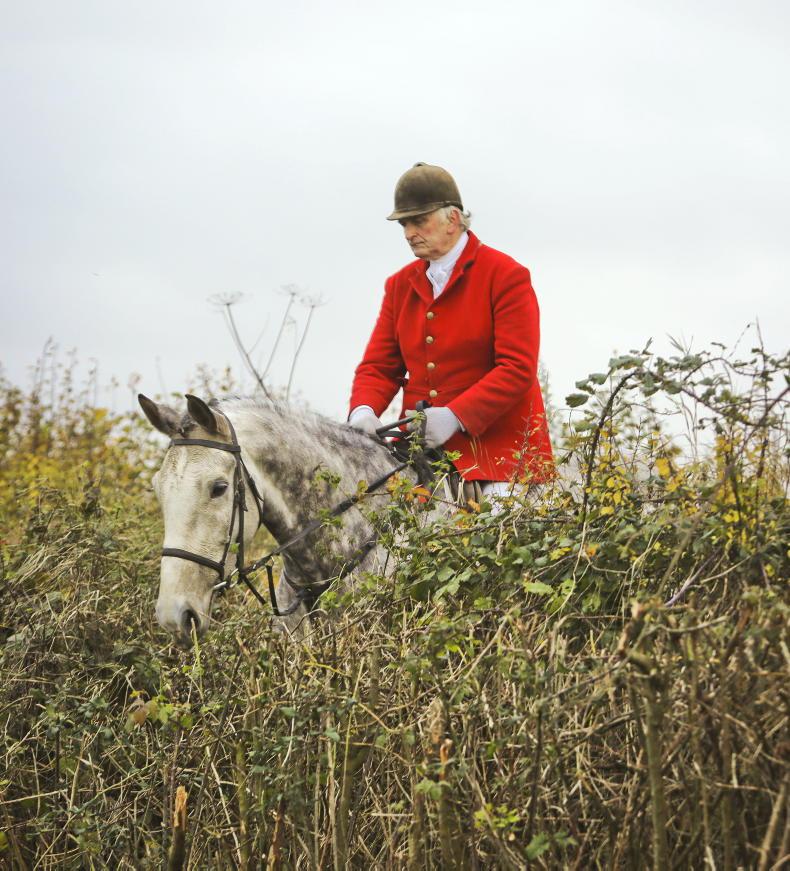
Senior master David Lalor. \ John O'Carroll
A magnetic character with a roguish sense of humour, he knows everyone and has sat on every committee. His impeccable farming credentials have helped to ensure that the hunt meets with a welcome from farmers across the county.
The half-hearted light of an overcast November day is fading and we are sitting on our horses in a field behind Ballinphrase House, waiting while huntsman Mike Comerford calls up his hounds. There is an appealing timelessness to the scene – the hounds, the horses chomping at their bits, the red and the black coats, the top-boots and high-crowned hunting caps, the chimneys of the 18th century house glimpsed through the nearly leafless trees.
A lively scurry
An unseasonably dry, mild start to the winter has meant that scenting conditions are poor and hounds have had to work really hard to show any sport.
Nonetheless, it has been a busy day, with plenty of country crossed and some entertaining jumping. Our last fox of the day took us on a lively scurry from Ballinphrase out over a stone-faced bank into Jack Dillon’s farm.
Hounds hunted with wonderful cry and drive through Mike Dunphy’s beet then circled back left-handed to their original location before the scent simply fizzled out.
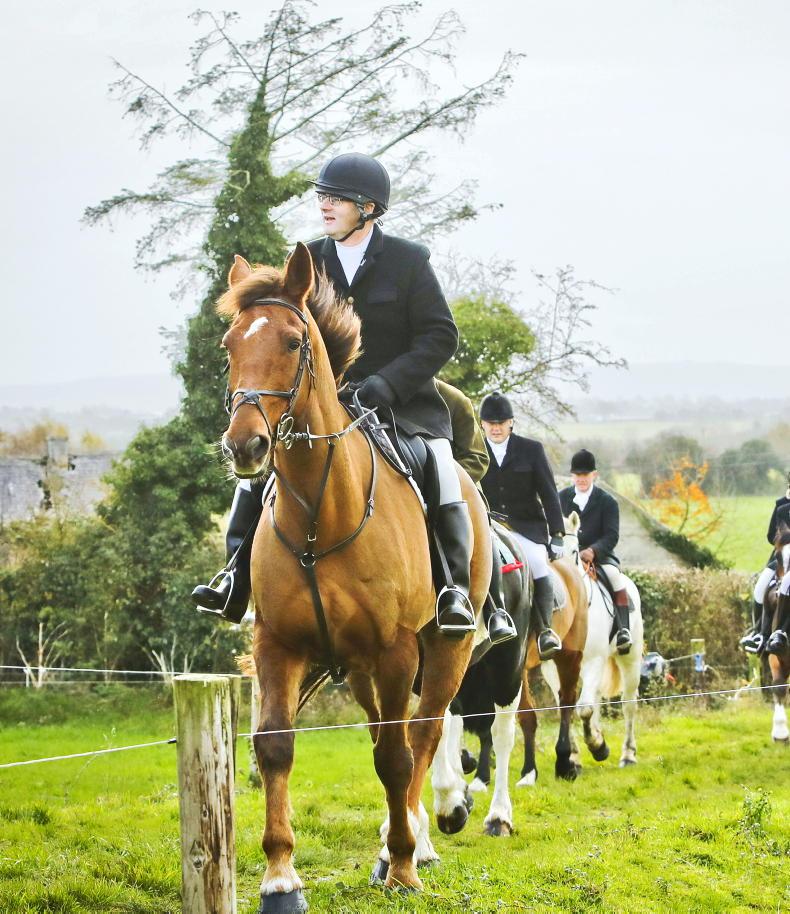
Sheep & suckler farmer Tomas Murphy. \ John O'Carroll
Ideally, hounds should mark their fox to ground, so that a hunt has a beginning, a middle and an end but, more often than not, our quarry will outwit us and simply disappear.
Contrary to the claims of our opponents, no one goes hunting to see a fox killed. 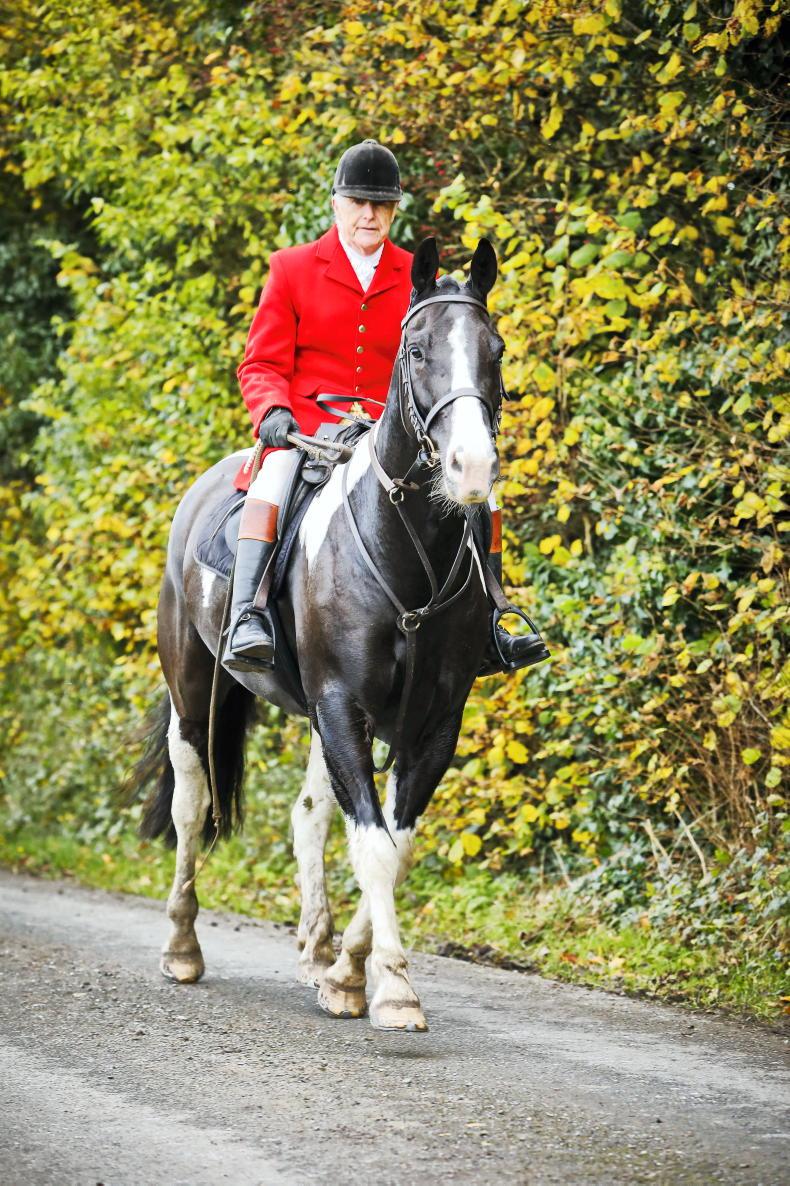
The digging out of a fox marked to ground (when hounds dig or scratch at the earth where the fix has gone to ground) is legal and may be desirable in areas with, say, a lot of sheep-farming. However, many people within and outside of hunting feel an instinctive revulsion at the thought of digging out a fox and few of us would be sorry were the practice to be discontinued entirely.
Of a mounted field of 30 or so who clattered away from the meet in Galmoy that morning, only a dozen of us remain, tired but content, sharing the unique camaraderie of the hunting field. Over the years we have all have shared exhilarating runs, caught each other’s horses after thumping falls, and endured every extreme of weather the Irish winter can throw at us. Friendships forged out hunting are very special friendships.
The Laois
Every hunt has its own distinctive character; from the notoriously hard-riding and the unambitious but friendly, to the snooty and exclusive or the dog-rough and proud of it.

Paediatric nurse Emily Hanniffy. \ John O'Carroll
The Laois has never been a particularly fashionable pack. This is a cold-scenting country, where conditions have to be just right to produce a flying hunt, and there has always been too much covert for foxes to duck and dive into. It is primarily a bank and ditch country, best suited to a smallish, clever horse who can think on its feet. The ideal hunter is really a matter of personal taste.
Some people swear by the Irish Draught and others say the more blood the better. There are few professional horse people among the membership of the Laois. They are farmers, nurses, vets, teachers, accountants. Whatever they may do on non-hunting days, I have never hunted with a warmer or more good-natured group of people.
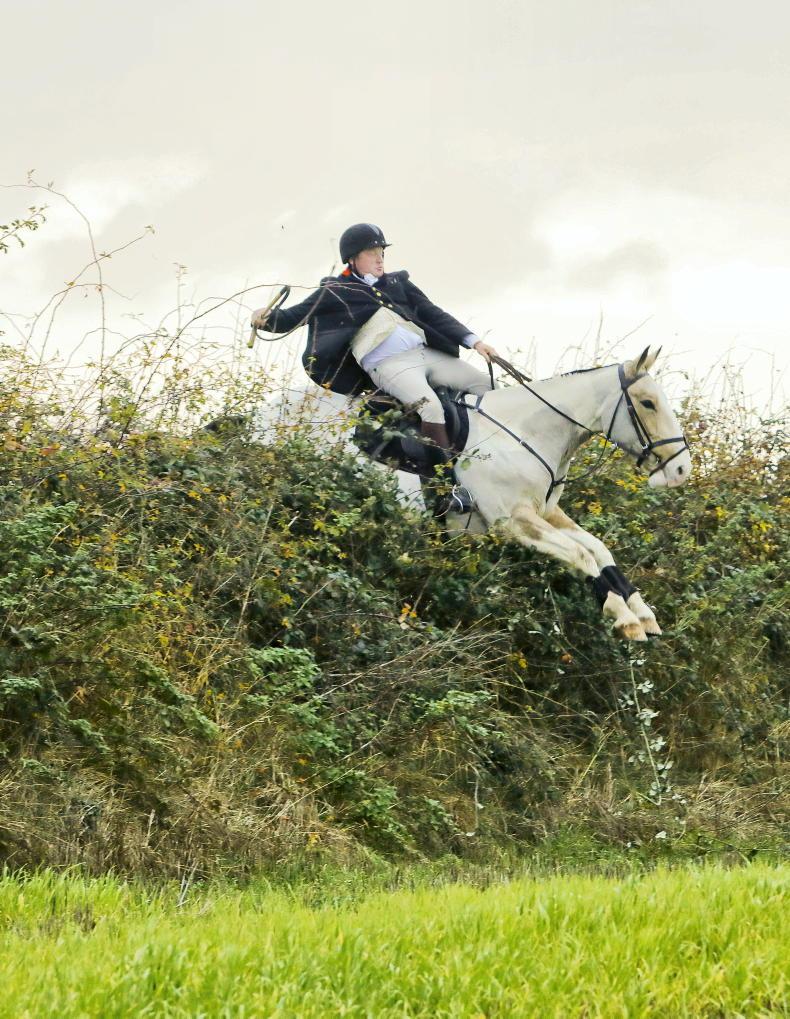
Local garda and amateur whipper-in Shane Barry jumps a hedge. \ John O'Carroll
“The people are what makes the Laois special,” enthuses joint master Marcus McLoughlin. “No one’s ever gone away and felt unwelcome.”
Mike Comerford has worked as hard as his hounds all day, always watching and listening, crossing the country effortlessly on his good horse and quietly helping the hounds whenever they were at a loss. Assisting him are amateur whippers-in Shane Barry and Colm Gainey.
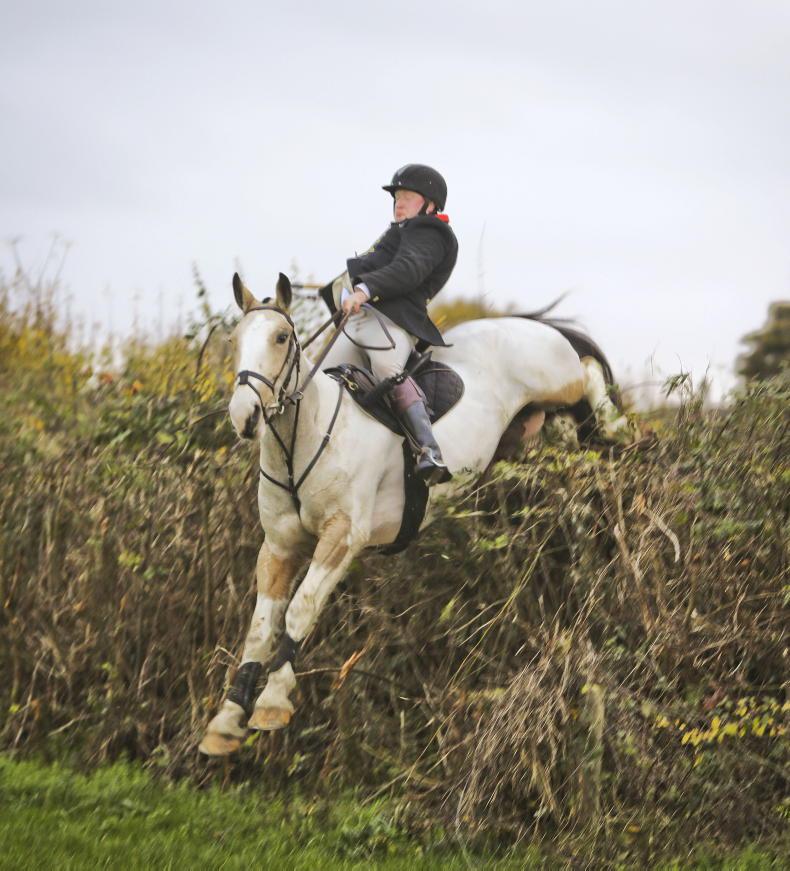
Local garda and amateur whipper-in Shane Barry jumps a hedge. \ John O'Carroll
Shane is a garda from Stradbally whose other passion is falconry. Colm is a former jockey who, at the age of 69, realized a lifelong ambition last year when he was formally accepted as a whipper-in. No one has ever been prouder of his red coat.
“I love to see the hounds hunting,” he says. “I love the bit of craic and the social end of it – that’s what the Laois are known for, isn’t it?”
“I’m always delighted to see Colm out hunting,” Lalor adds, with his customary lopsided grin. “It means I’m not the oldest out.”
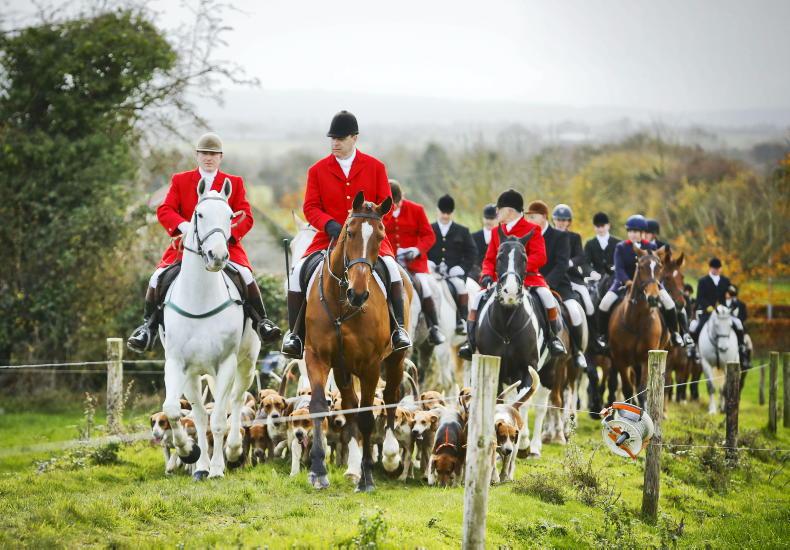
Coming full circle
Mike Comerford hunted with the Laois as a child when David Lalor’s uncle Dessie was huntsman. 
He carried the horn to the Golden Vale Hunt in north Tipperary for ten seasons before coming full circle and accepting the post of professional huntsman to the Laois this season. Though a quiet, undemonstrative man, he lights up when the conversation turns to his hounds.
Mike is, of course, a purist, but even he acknowledges that people go hunting for all sorts of reasons. Some, many of whom follow on foot or by car, are fascinated by the hound work. There are those who hunt purely for the challenge of riding over an unprepared line of country and staying in touch with hounds come what may. Others are drawn to the undoubted romance of fox hunting or come out to catch up on the local gossip.
“It’s a social outlet for me,” says sheep and suckler farmer Tomas Murphy.
“Farming is such a lonely occupation at the moment and you get out and meet your friends on a Wednesday and a Saturday.”
Jim Fennelly was a truck driver with the ESB before an accident left him requiring a wheelchair permanently. He faithfully follows the hunt in his van twice a week and makes himself useful in a variety of roles from providing an escort to members hacking home in the dark to delivering David Lalor’s ham and cheese roll in the late afternoon. 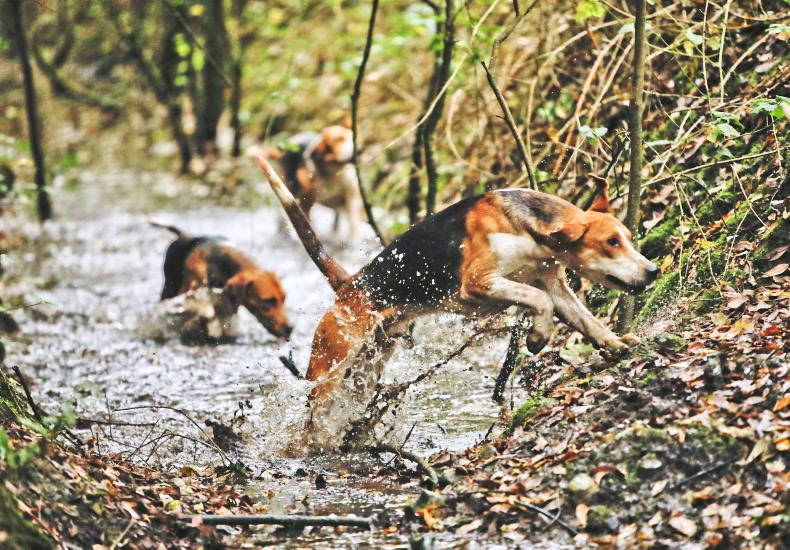
Perhaps none of us gets as much pleasure from his hunting as Jim. “Wednesday and Saturday are my days,” he says. “I love the outdoor life and the crowd and the hunt itself – to hear the hounds singing along the fields is beautiful. The hunt is a family to me and everyone in it is really so good to me. I never was left behind.”
Storm clouds gathering
Not even the most optimistic member can fail to see that there are worrying clouds on the horizon. Hard-pressed young dairy farmers who have invested frightening amounts of money in their farms do not necessarily see any good reason why they should allow the local hunt access to their land. The attitude of an increasingly urbanised population toward traditional fieldsports is slowly tipping from indifference to hostility.

The most immediately worrying development is the difficulty of obtaining insurance for a dangerous and unpredictable sport in a culture where no one seems prepared to accept the consequences of their own choices. Following some extraordinary cases of injured members suing their own hunts in recent years, the firms that traditionally underwrote insurance for Irish hunts have pulled out of the market.
Many hunts across the country have had to suspend their activities this season while they work out a whole new approach to insuring their clubs.

Between fretting over insurance, dealing with disgruntled farmers, and accusations of being a blood-thirsty psychopath from complete strangers on social media, there are times when it all feels like a little more trouble than it is worth. But then, late on a winter afternoon you find yourself at the side of a covert where hounds are drawing and on the other side of the wood you hear the whipper-in give a view holloa – that indescribable primitive shriek that announces a fox has broken for open country.

Your horse is all life and fire under you as hounds come spilling out into the open in a tri-coloured torrent. They momentarily overshoot the line of their quarry, then come together in glorious full cry, and the huntsman is doubling his horn furiously as he canters on the flank of the pack. At a gesture from the master, the entire mounted field surges forward in a great mass of pounding hooves and flying mud. The huntsman has jumped a brambly, untidy hedge in front of you, and as your horse meets it on a big forward stride and takes to the air, the thought flashes through your mind that at such moment’s one is truly alive.
The last light has drained from the sky by the time Mike has gathered up all of his hounds. They patiently wait with the whippers-in at the back gate of Ballinphrase while Mike and some of the last hangers-on arrange lifts to Galmoy to fetch trucks and trailers.

Jim Fennelly. \ Catherine Power
Others choose to hack back to the village, their way lit by Jim Fennelly’s headlights and the moon that appears fleetingly between the clouds.
As the clopping hooves fade into the darkness I am reminded of the closing lines of an old Will Ogilvie poem:
Miles grow gay for him,
Night grows day for him,
Long wet lanes with her smile are strewn;
Cares make way for him –
Him that for love hath the Hunter’s Moon.

David Thompson, stock manager on the Abbeyleix Estate.
Read more
‘If I ever write my autobiography, I think I’ll call it Horses and Women’
Great Irish Paintings: ‘The Biggest Walls in the Counthry was in it’ by Snaffles
“I hunt to forget all my troubles,” David Lalor tells me, sitting easy in the saddle of his big, sedate grey gelding.
“When you’re out here you forget any woes that you might have. I enjoy the countryside and the craic, I enjoy the hounds hunting – there’s nothing about it I don’t like.”
Lalor, whose life has been dedicated to farming and the mastership of the Laois hunt, does not come across as a man beset by woes.
He runs a large mixed farm in Ballacolla, where he has hosted the National Ploughing Championships on three occasions.

Senior master David Lalor. \ John O'Carroll
A magnetic character with a roguish sense of humour, he knows everyone and has sat on every committee. His impeccable farming credentials have helped to ensure that the hunt meets with a welcome from farmers across the county.
The half-hearted light of an overcast November day is fading and we are sitting on our horses in a field behind Ballinphrase House, waiting while huntsman Mike Comerford calls up his hounds. There is an appealing timelessness to the scene – the hounds, the horses chomping at their bits, the red and the black coats, the top-boots and high-crowned hunting caps, the chimneys of the 18th century house glimpsed through the nearly leafless trees.
A lively scurry
An unseasonably dry, mild start to the winter has meant that scenting conditions are poor and hounds have had to work really hard to show any sport.
Nonetheless, it has been a busy day, with plenty of country crossed and some entertaining jumping. Our last fox of the day took us on a lively scurry from Ballinphrase out over a stone-faced bank into Jack Dillon’s farm.
Hounds hunted with wonderful cry and drive through Mike Dunphy’s beet then circled back left-handed to their original location before the scent simply fizzled out.

Sheep & suckler farmer Tomas Murphy. \ John O'Carroll
Ideally, hounds should mark their fox to ground, so that a hunt has a beginning, a middle and an end but, more often than not, our quarry will outwit us and simply disappear.
Contrary to the claims of our opponents, no one goes hunting to see a fox killed. 
The digging out of a fox marked to ground (when hounds dig or scratch at the earth where the fix has gone to ground) is legal and may be desirable in areas with, say, a lot of sheep-farming. However, many people within and outside of hunting feel an instinctive revulsion at the thought of digging out a fox and few of us would be sorry were the practice to be discontinued entirely.
Of a mounted field of 30 or so who clattered away from the meet in Galmoy that morning, only a dozen of us remain, tired but content, sharing the unique camaraderie of the hunting field. Over the years we have all have shared exhilarating runs, caught each other’s horses after thumping falls, and endured every extreme of weather the Irish winter can throw at us. Friendships forged out hunting are very special friendships.
The Laois
Every hunt has its own distinctive character; from the notoriously hard-riding and the unambitious but friendly, to the snooty and exclusive or the dog-rough and proud of it.

Paediatric nurse Emily Hanniffy. \ John O'Carroll
The Laois has never been a particularly fashionable pack. This is a cold-scenting country, where conditions have to be just right to produce a flying hunt, and there has always been too much covert for foxes to duck and dive into. It is primarily a bank and ditch country, best suited to a smallish, clever horse who can think on its feet. The ideal hunter is really a matter of personal taste.
Some people swear by the Irish Draught and others say the more blood the better. There are few professional horse people among the membership of the Laois. They are farmers, nurses, vets, teachers, accountants. Whatever they may do on non-hunting days, I have never hunted with a warmer or more good-natured group of people.

Local garda and amateur whipper-in Shane Barry jumps a hedge. \ John O'Carroll
“The people are what makes the Laois special,” enthuses joint master Marcus McLoughlin. “No one’s ever gone away and felt unwelcome.”
Mike Comerford has worked as hard as his hounds all day, always watching and listening, crossing the country effortlessly on his good horse and quietly helping the hounds whenever they were at a loss. Assisting him are amateur whippers-in Shane Barry and Colm Gainey.

Local garda and amateur whipper-in Shane Barry jumps a hedge. \ John O'Carroll
Shane is a garda from Stradbally whose other passion is falconry. Colm is a former jockey who, at the age of 69, realized a lifelong ambition last year when he was formally accepted as a whipper-in. No one has ever been prouder of his red coat.
“I love to see the hounds hunting,” he says. “I love the bit of craic and the social end of it – that’s what the Laois are known for, isn’t it?”
“I’m always delighted to see Colm out hunting,” Lalor adds, with his customary lopsided grin. “It means I’m not the oldest out.”

Coming full circle
Mike Comerford hunted with the Laois as a child when David Lalor’s uncle Dessie was huntsman. 
He carried the horn to the Golden Vale Hunt in north Tipperary for ten seasons before coming full circle and accepting the post of professional huntsman to the Laois this season. Though a quiet, undemonstrative man, he lights up when the conversation turns to his hounds.
Mike is, of course, a purist, but even he acknowledges that people go hunting for all sorts of reasons. Some, many of whom follow on foot or by car, are fascinated by the hound work. There are those who hunt purely for the challenge of riding over an unprepared line of country and staying in touch with hounds come what may. Others are drawn to the undoubted romance of fox hunting or come out to catch up on the local gossip.
“It’s a social outlet for me,” says sheep and suckler farmer Tomas Murphy.
“Farming is such a lonely occupation at the moment and you get out and meet your friends on a Wednesday and a Saturday.”
Jim Fennelly was a truck driver with the ESB before an accident left him requiring a wheelchair permanently. He faithfully follows the hunt in his van twice a week and makes himself useful in a variety of roles from providing an escort to members hacking home in the dark to delivering David Lalor’s ham and cheese roll in the late afternoon. 
Perhaps none of us gets as much pleasure from his hunting as Jim. “Wednesday and Saturday are my days,” he says. “I love the outdoor life and the crowd and the hunt itself – to hear the hounds singing along the fields is beautiful. The hunt is a family to me and everyone in it is really so good to me. I never was left behind.”
Storm clouds gathering
Not even the most optimistic member can fail to see that there are worrying clouds on the horizon. Hard-pressed young dairy farmers who have invested frightening amounts of money in their farms do not necessarily see any good reason why they should allow the local hunt access to their land. The attitude of an increasingly urbanised population toward traditional fieldsports is slowly tipping from indifference to hostility.

The most immediately worrying development is the difficulty of obtaining insurance for a dangerous and unpredictable sport in a culture where no one seems prepared to accept the consequences of their own choices. Following some extraordinary cases of injured members suing their own hunts in recent years, the firms that traditionally underwrote insurance for Irish hunts have pulled out of the market.
Many hunts across the country have had to suspend their activities this season while they work out a whole new approach to insuring their clubs.

Between fretting over insurance, dealing with disgruntled farmers, and accusations of being a blood-thirsty psychopath from complete strangers on social media, there are times when it all feels like a little more trouble than it is worth. But then, late on a winter afternoon you find yourself at the side of a covert where hounds are drawing and on the other side of the wood you hear the whipper-in give a view holloa – that indescribable primitive shriek that announces a fox has broken for open country.

Your horse is all life and fire under you as hounds come spilling out into the open in a tri-coloured torrent. They momentarily overshoot the line of their quarry, then come together in glorious full cry, and the huntsman is doubling his horn furiously as he canters on the flank of the pack. At a gesture from the master, the entire mounted field surges forward in a great mass of pounding hooves and flying mud. The huntsman has jumped a brambly, untidy hedge in front of you, and as your horse meets it on a big forward stride and takes to the air, the thought flashes through your mind that at such moment’s one is truly alive.
The last light has drained from the sky by the time Mike has gathered up all of his hounds. They patiently wait with the whippers-in at the back gate of Ballinphrase while Mike and some of the last hangers-on arrange lifts to Galmoy to fetch trucks and trailers.

Jim Fennelly. \ Catherine Power
Others choose to hack back to the village, their way lit by Jim Fennelly’s headlights and the moon that appears fleetingly between the clouds.
As the clopping hooves fade into the darkness I am reminded of the closing lines of an old Will Ogilvie poem:
Miles grow gay for him,
Night grows day for him,
Long wet lanes with her smile are strewn;
Cares make way for him –
Him that for love hath the Hunter’s Moon.

David Thompson, stock manager on the Abbeyleix Estate.
Read more
‘If I ever write my autobiography, I think I’ll call it Horses and Women’
Great Irish Paintings: ‘The Biggest Walls in the Counthry was in it’ by Snaffles















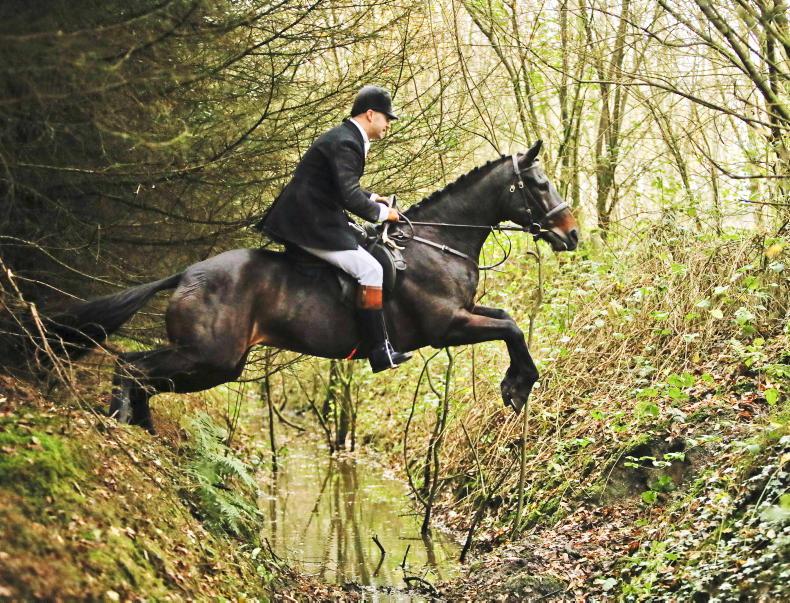




 This is a subscriber-only article
This is a subscriber-only article










SHARING OPTIONS: